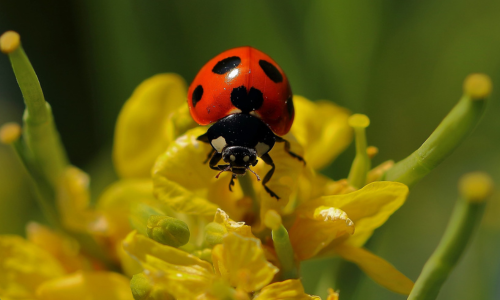To be honest, until I began researching for this article, I didn’t realize that there was more than one type of ladybug, but instead made the naive assumption that ladybugs came in various colors. Though when I pondered this assumption, it dawned on me that, at least in Michigan, I never saw orange, brown, or yellow ladybugs as a child. They were always red.
Come to find out, the Asian ladybug, also known as the Asian lady beetle, was first imported into the United States in 1916, though it died off. It was reintroduced to California in 1964 and 1965, but again failed to thrive. Apparently, it really "took" after a 1988 release in Louisiana, where the beetle then subsequently traveled to nearly all corners of North America. Its popularity first grew in the Northwestern U.S., followed by the Northeastern, and then to Michigan and other parts of the Midwest.
What is the Asian lady beetle?

The name ladybug is quite misleading, since these insects are actually beetles. Perhaps you should consider using the term "ladybird beetle" or "lady beetle" the next time this most beloved and respected of insects comes up in conversation? If so, and while you’re at it, let’s make sure that you’re using the word mischievous correctly—pronounced MIS-chuh-vus (not mis-CHEE-vee-us). This ladybird beetle, in addition to several others, also goes by these names: Asian ladybug, Japanese lady beetle, multicolored Asian lady beetle, and the Halloween lady beetle, as the adults begin moving indoors around October. The term ladybug is slang.
Is a ladybug actually a bug?
Although I, too, am using the slang word in this writing, it’s important to note that ladybugs are not actually bugs. "True bugs," like aphids, butterflies, and bedbugs, have a mouth shaped like a needle (a proboscis), which looks like a long beak and operates like a drinking straw, from which they suck juices. The ladybug does not have a proboscis. Rather, it has razor sharp mouthparts (not teeth) that allows it to chew and, if it's an Asian lady beetle, bite you or me.
Difference between the Asian lady beetle & the native ladybug?
Upon first glance, the Asian ladybug (or Asian beetle) and the native ladybug look alike. You could easily assume that these foreign beetles are in fact native ladybugs. Their one key and very noticeable difference is that Asian ladybugs have distinct markings on their pronotum. This difference, along with a multitude of others, are listed for your reference.
Asian ladybugs

- Pronotum: Distinct white M (or W) on their pronotum, which is the area between the head and the body
- Color: Various colors - orange, yellow, brown, black, yellow, and white
- Spots: 2-19
- Size: 7-15 mm, or approximately ¼ to ½ inch long
- Temperament: Aggressive. They bite by scraping the skin they land on and leave a foul-smelling secretion on surfaces where they gather
- Harmful to pets: Possibly. If your furball eats a few dozen, he can become lethargic, get ulcers, start foaming at the mouth, and experience vomiting and diarrhea
- OK to squash: No. When threatened or crushed, they tend to leave a foul-smelling yellow secretion from their leg joints that stains upholstery and walls
- Congregate: Yes. They can amass in huge numbers
- Habitat: Will invade homes to seek shelter during the winter
Native ladybugs

- Pronotum: Shiny and black with two tiny white circles that look like cheeks
- Color: Red, typically bright, but sometimes pale
- Spots: 9, 4 on each wing and 1 that is split in the middle
- Size: 3 to 6 mm, which is just short of ¼ inch
- Temperament: Mild. They do not bite
- Harmful to pets: No
- OK to squash: Yes. But, consider their many benefits first
- Congregate: No. Often found solitary
- Habitat: Seek shelter outdoors
It’s important to emphasize that Asian lady beetles will bite, but that typically, their bite only leaves a mostly harmless red mark on your skin, as their mandibles do not hold enough power to cause lasting damage. Second, they can be harmful and, if enough are eaten, even poisonous to your cat or dog, sending you both to the vet. (Someone has to drive your beloved furball.) Third, Asian lady beetles, if they find entrance into your home, may take refuge in your siding, wall crevices, light sockets, and foundational spaces.
How do I get rid of the Asian lady beetle?
If you're dealing with an Asian lady beetle infestation, there are multiple strategies you can adopt to manage and even prevent their recurrence:
Vacuum up
For minor infestations, consider using a vacuum cleaner to gently remove the beetles without harming them. This method avoids the release of odorous fluids and pheromones that occur when beetles are crushed, potentially attracting more beetles. Once vacuumed, you can release them far from your home, thus dealing with the problem humanely.

Use Dr. Killigan’s Six Feet Under
For a more assertive approach, generally disperse our child and pet-safe kill-on-contact insect spray. It's important to treat surfaces where beetles congregate to eliminate pheromone trails that attract additional beetles, ensuring your efforts have long-lasting effectiveness.
Disperse Dust to Dust
For areas prone to beetle entry, use Dr. Killigan’s Insect Buster, a precise distribution method for applying Dust to Dust. Proven to have kill times up to 50% faster than diatomaceous earth, Dust to Dust Non-Toxic Insect Powder is a safe and more effective alternative to diatomaceous earth for insect control. Puff this powder around the windows and doors of your home, along with any cracks or crevices where Asian lady beetles might gain entry.
Plant chrysanthemums
Ladybugs (our lady beetles), regardless of whether they’re native or Asian, do not like mums. Plant or pot these brilliantly colored flowers around your windows and the entrance to your home to keep those insects away.





















